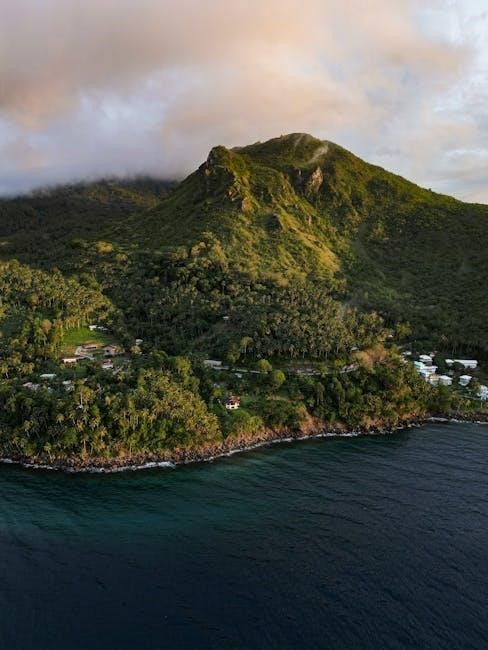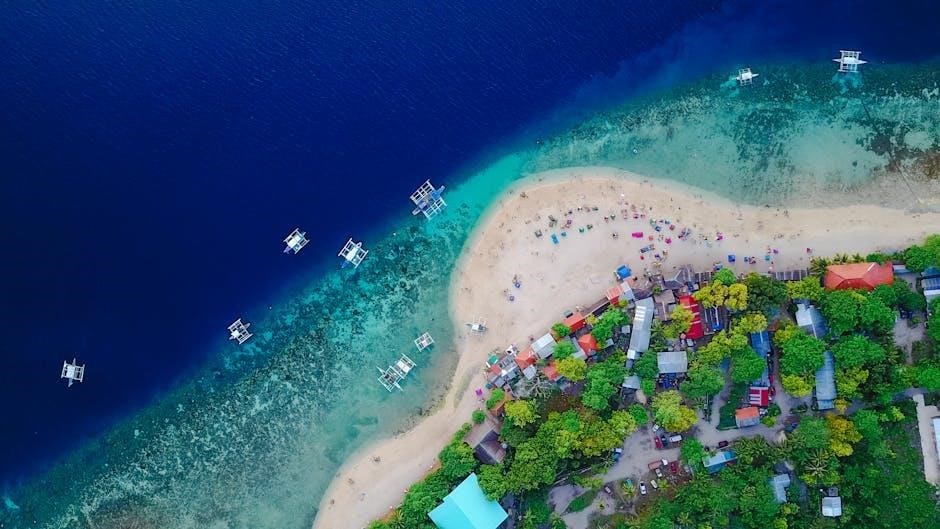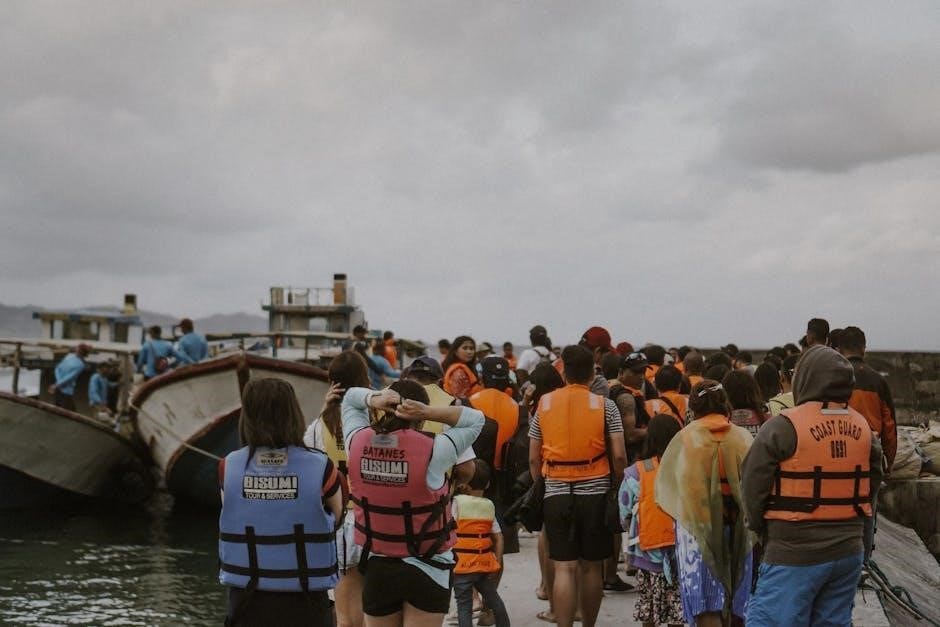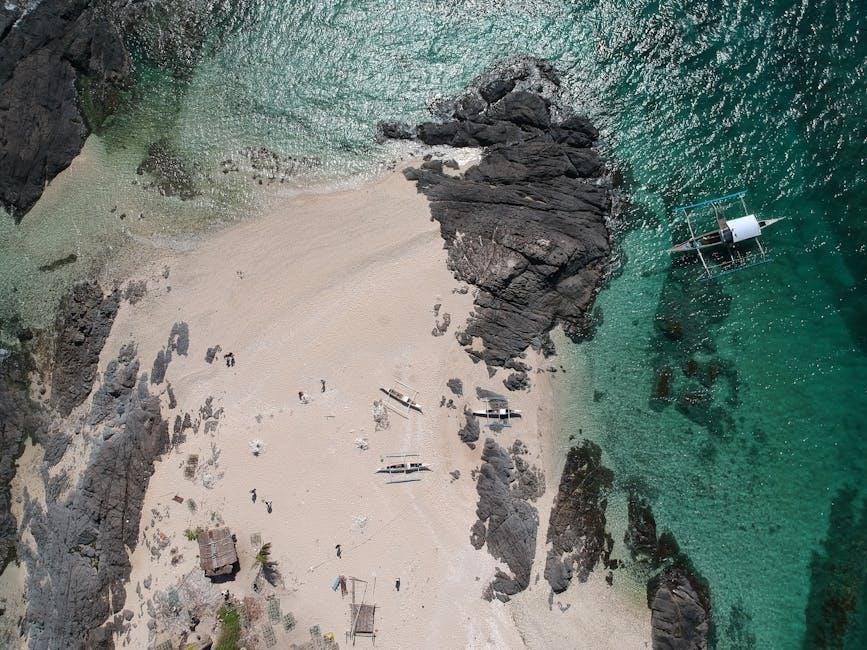The Philippines, an archipelago of 7,641 islands in Southeast Asia, offers stunning beaches, vibrant culture, and breathtaking landscapes. From Manila’s historic sites to Palawan’s natural wonders, it captivates travelers with its unique blend of festivals, delicious cuisine, and warm hospitality, making it a must-visit destination for any explorer.
Overview of the Philippines
The Philippines, an archipelago of 7,641 islands in Southeast Asia, is renowned for its rich biodiversity, stunning landscapes, and vibrant culture. Located near the Pacific Ocean, it boasts mountains, beaches, and rainforests; The capital, Manila, is a bustling hub of history and modernity. With a mix of indigenous, Spanish, and American influences, the Philippines offers a unique cultural experience. Friendly locals, colorful festivals, and diverse cuisine make it a captivating destination for global travelers seeking adventure and relaxation.
Why Visit the Philippines?
The Philippines is a treasure trove of natural wonders, vibrant culture, and warm hospitality. Its stunning beaches, crystal-clear waters, and lush landscapes offer endless opportunities for adventure. From snorkeling in Palawan to exploring Manila’s historical sites, there’s something for every traveler. The country’s rich festivals, delicious cuisine, and friendly locals create unforgettable experiences. With its unique charm and diverse attractions, the Philippines is a must-visit destination for any traveler seeking adventure, relaxation, and cultural immersion.
Best Time to Visit the Philippines
The best time to visit the Philippines is during the dry season, from December to May, offering ideal weather for island hopping and outdoor activities.
Weather and Climate
The Philippines has a tropical maritime climate, characterized by high humidity and average temperatures ranging from 22°C to 32°C; The country experiences two main seasons: a dry season from December to May and a wet season from June to November. The dry season offers sunny conditions, while the wet season brings occasional rainfall. Regional variations exist, with some areas like the Cagayan Valley experiencing more pronounced rainfall patterns. The climate is ideal for tropical getaways, with warm weather prevailing year-round.
Seasonal Activities and Events
The Philippines offers vibrant seasonal activities and events. The dry season (December to May) is perfect for beach trips, island hopping, and outdoor adventures like hiking and diving. Key festivals include the Sinulog in January and MassKara in October. The wet season (June to November) showcases lush landscapes, ideal for trekking and exploring waterfalls. Holy Week in April is a significant religious event, while summer months highlight cultural celebrations and local traditions, making the Philippines a year-round destination for diverse experiences.

Philippines Travel Itinerary
Explore the Philippines with tailored itineraries for 1-3 weeks, featuring tropical getaways, cultural explorations, and adventure activities. Customize your journey to suit your interests and travel style.
1-Week Itinerary: Tropical Island Getaway
Experience a tropical paradise in just one week. Start in Manila, then fly to Palawan for stunning beaches and crystal-clear waters. Explore El Nido’s iconic lagoons, snorkel in Bacuit Bay, and relax on Nacpan Beach. Visit vibrant coral reefs and enjoy fresh seafood. Conclude your trip with a scenic boat tour and unforgettable sunsets. This itinerary offers a perfect blend of adventure, relaxation, and breathtaking natural beauty, making it an ideal getaway for travelers seeking tranquility and inspiration.
2-Week Itinerary: Exploring Major Destinations
Discover the Philippines’ diverse charm with this 2-week itinerary. Start in Manila, exploring Intramuros and Bonifacio Global City. Fly to Palawan for stunning beaches and El Nido’s iconic lagoons. Visit Cebu to see Magellan’s Cross and vibrant nightlife. Head to Bohol for Chocolate Hills and tarsier encounters. End your trip in Siargao, surfing its famous waves or relaxing on pristine beaches. This journey captures the essence of the Philippines’ natural beauty and cultural richness, ensuring unforgettable experiences.
3-Week Itinerary: Extended Adventure
Embark on an extended Philippine adventure, exploring its diverse landscapes and cultures. Begin in Manila, then head to Palawan for El Nido’s lagoons and Coron’s diving spots. Visit Cebu to explore Oslob’s whalesharks and vibrant city life. Discover Bohol’s Chocolate Hills and tarsiers, and relax in Siargao’s beaches.venture to Siquijor for mystical experiences and pristine coves. End your journey with a day trip to Batanes, soaking in its rugged beauty and unique culture. This itinerary offers a deep dive into the Philippines’ natural and cultural wonders.

Getting Around the Philippines
The Philippines offers diverse transportation options, including ferries, flights, and land travel. Jeepneys, taxis, and tricycles provide affordable and accessible ways to explore its vibrant islands and cities.
Transportation Options: Ferries, Flights, and Land Travel
Ferries connect major islands, with routes from Cebu and Bohol to destinations like Siquijor. Domestic flights offer quick access to remote areas. Land travel includes buses and jeepneys, with fixed routes and affordable fares (PHP 5–30). Tricycles provide short-distance transport, ideal for exploring local areas. These options ensure seamless travel across the Philippines’ diverse landscapes and cultures.
Navigating Local Transport: Jeepneys, Taxis, and More
Jeepneys are iconic, cost-effective transport, with fares starting at PHP 5. Taxis offer convenience, while tricycles are ideal for short distances. Always check routes beforehand, as jeepneys have fixed paths. Tricycles are perfect for navigating narrow streets. For seamless travel, carry exact change and stay informed about local transport options to explore the Philippines effortlessly.

Top Destinations in the Philippines
Discover Manila’s vibrant culture, Palawan’s stunning beaches, and Siquijor’s hidden charm. These destinations offer a mix of urban excitement, natural beauty, and serene escapes.
Manila: The Capital City
Manila, the vibrant capital of the Philippines, seamlessly blends history with modernity. Explore Intramuros, the walled city, and visit landmarks like Fort Santiago and Manila Cathedral. The city’s dynamic energy is reflected in its bustling streets, shopping districts like Greenhills, and the trendy Bonifacio Global City. Manila offers a mix of cultural experiences, from historical sites to lively nightlife, making it a fascinating destination for travelers seeking both heritage and contemporary charm.
Palawan: El Nido and Beyond
Palawan, often hailed as the Philippines’ “Last Frontier,” captivates with its pristine beaches, crystal-clear lagoons, and towering limestone cliffs. El Nido is a highlight, offering island-hopping tours to Big Lagoon and Small Lagoon. Beyond El Nido, Coron enchants with its hot springs and shipwreck diving, while Puerto Princesa’s Subterranean River is a natural wonder. Palawan’s untouched beauty and diverse ecosystems make it a paradise for nature lovers and adventure seekers alike.
Siquijor: Off-the-Beaten-Path
Siquijor, a lesser-known gem, offers serene landscapes and mystical charm. Accessible via ferries from Cebu or Bohol, it remains untouched by mass tourism. The island boasts stunning beaches, waterfalls, and hiking trails, perfect for nature enthusiasts. Its reputation for traditional healers and folklore adds intrigue, making it a unique destination for curious travelers seeking an authentic experience away from the crowds.

Accommodation in the Philippines
The Philippines offers diverse lodging options, from budget-friendly guesthouses to luxury resorts. Prices vary, with Manila being pricier than provincial areas, ensuring choices for all travelers.
Budget-Friendly Options
Travelers can find affordable accommodations in the Philippines, with hostels and guesthouses starting from 500 PHP (≈10 USD) per night. These options often include basic amenities and are centrally located. Local inns, known as pension houses, are another cost-effective choice, offering cozy rooms at budget-friendly rates. Booking in advance and exploring options outside major cities can further reduce costs, making your Philippine adventure accessible and enjoyable without breaking the bank.
Luxury Resorts and Hotels
The Philippines boasts luxurious resorts and hotels that offer world-class amenities and unparalleled service. From beachfront villas in El Nido to 5-star hotels in Manila, these properties cater to discerning travelers. Many resorts feature private pools, spas, and fine dining options. Amanpulo in Palawan and Shangri-La Boracay are top choices, offering seclusion and opulence. These high-end accommodations provide the perfect blend of comfort, exclusivity, and access to the country’s stunning natural beauty, ensuring a memorable and indulgent stay.

Safety Tips for Travelers
Exercise caution due to terrorism and crime risks. Stay informed, avoid displaying valuables, and use reputable transport. Respect local warnings and authorities’ guidelines for a safe trip.
General Safety Advice
Exercise high caution in the Philippines due to terrorism and violent crime risks. Avoid displaying valuables, use reputable transport, and stay informed about local conditions. Register your travel via the eTravel Card for smooth arrival. Avoid traveling to high-risk areas and follow local authorities’ guidelines. Respect cultural norms and keep personal belongings secure, especially in crowded spaces. Stay vigilant and plan ahead to ensure a safe and enjoyable journey throughout the islands.
Understanding Local Customs and Etiquette
Respecting Filipino customs enhances your travel experience. Greet locals with a smile and use polite phrases like “po” and “opo” when speaking to elders. Remove shoes before entering homes or religious sites. Avoid public displays of affection and dress modestly in churches. Tipping is appreciated but not mandatory. Understanding these cultural norms fosters positive interactions and shows respect for the Filipino way of life, enriching your journey through the islands.
Visa Requirements and Travel Documents
Most travelers receive a free 30-day visa upon arrival. Ensure your passport is valid for six months. Check specific entry requirements to avoid complications during your trip.
Visa Rules and Regulations
Most travelers receive a 30-day visa upon arrival, free of charge. Ensure your passport is valid for at least six months. For longer stays, apply for visa extensions or appropriate visa types (e.g., tourist, business, or student). Overstaying can result in penalties. Register with the eTravel Card for seamless entry and comply with all immigration regulations to avoid issues during your visit to the Philippines.
Using the eTravel Card for Seamless Travel
Register for the eTravel Card online to streamline your entry and exit processes in the Philippines. This digital system requires travelers to submit personal and trip details, obtaining a QR code for immigration. Ensure all information is accurate and submitted timely to avoid delays. The eTravel Card is mandatory for all arrivals, simplifying health and immigration procedures, making your journey efficient and stress-free from the moment you arrive in the Philippines.
Cultural Experiences in the Philippines
The Philippines offers vibrant festivals, rich traditions, and mouthwatering dishes, blending history with modern influences, providing travelers with unforgettable cultural experiences.
Festivals and Local Traditions
The Philippines is renowned for its vibrant festivals, showcasing rich cultural heritage. Events like Sinulog and Pahiyas highlight colorful parades, music, and dance, reflecting deep faith and traditions. Local customs, such as the Flores de Mayo and fiesta celebrations, emphasize community and family bonds. These festivals, steeped in history and spirituality, offer visitors a unique glimpse into the country’s soul, blending Spanish colonial influence with indigenous practices and modern Filipino culture.
Food and Drinks: A Taste of Filipino Culture
Filipino cuisine is a vibrant blend of Spanish, Chinese, and Malay flavors. Must-try dishes include adobo, lechon, sinigang, and sisig. Fresh seafood, like kinilaw, and street food such as balut are favorites. Local drinks like buko juice and fresh coconut water are refreshing. Desserts like ube halaya and leche flan showcase the country’s sweet side. The food reflects the Philippines’ rich history and hospitality, making every meal a cultural experience.

Practical Tips for Travelers
Plan ahead, research destinations, and pack essentials. Budget wisely for accommodation and transportation. Respect local customs to ensure a smooth and enjoyable travel experience.
Packing Essentials
When traveling to the Philippines, pack lightweight clothing, swimwear, and rain gear due to the tropical climate. Include sunscreen, a hat, sunglasses, and insect repellent for outdoor adventures. Bring toiletries, a reusable water bottle, and a universal power adapter. Don’t forget travel documents like your passport, visa, and eTravel Card. A small first-aid kit and snorkeling gear are also useful for island activities. Check baggage restrictions to avoid extra fees.
Using Technology for Navigation and Communication
Stay connected with prepaid SIM cards or portable Wi-Fi for reliable internet access. Use apps like Google Maps or Waze for navigation and Grab for transportation. Download Philippine-specific apps for weather updates, ferry schedules, and local guides. Consider registering for an eTravel Card to streamline travel documentation. Ensure your devices are compatible with local power outlets and consider packing a universal adapter for convenience during your trip.
